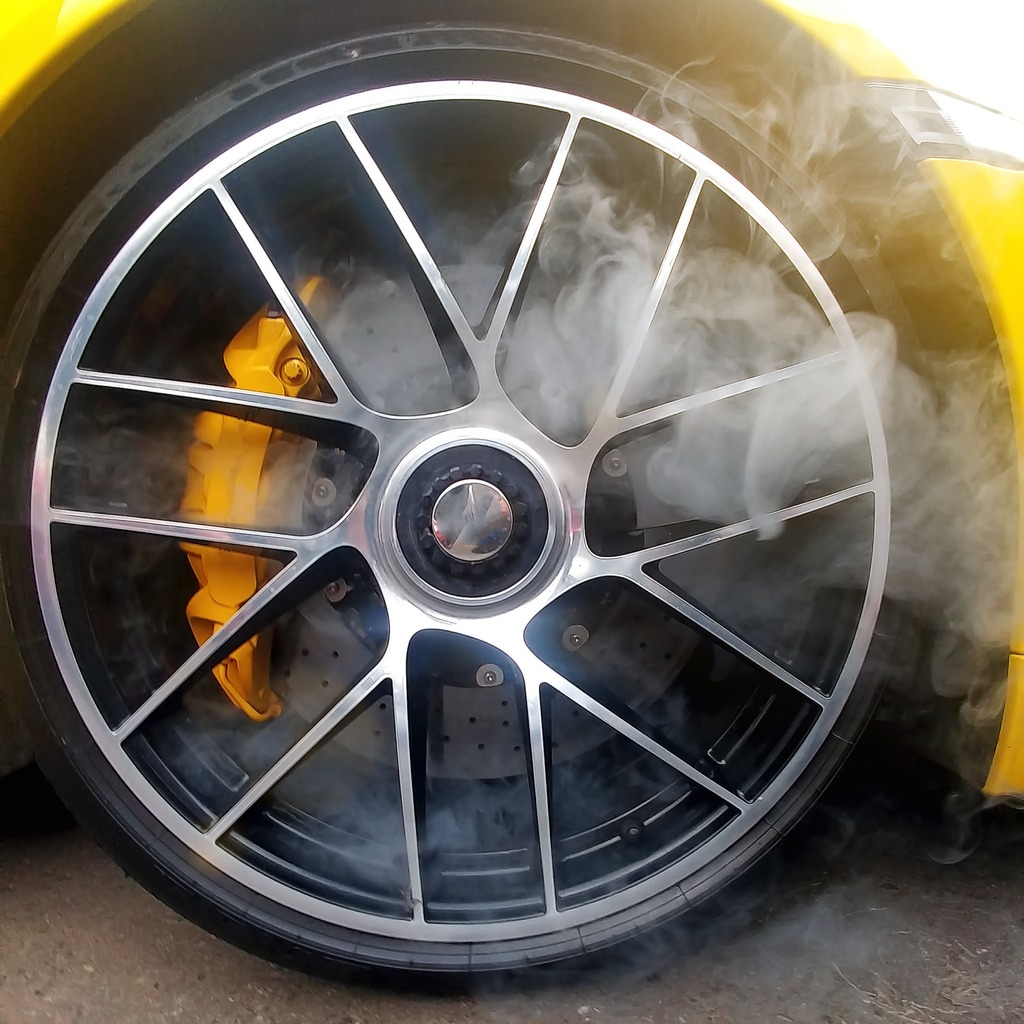When shopping for a new car, we often focus on its looks, the interior comforts, and how well the engine performs. However, the braking system, which might be a standard feature or an optional extra, often gets less attention. This oversight can be particularly significant for sports car enthusiasts who might be choosing between carbon-ceramic brakes and other types. Notably, while high-end brands like Ferrari, Lamborghini, and McLaren typically include these brakes as standard, other supersports cars offer them as an upgrade.
Brakes are vital in high-performance vehicles, and carbon ceramic brakes are often the top pick for luxury and sports cars. But why are they so popular? What sets them apart from regular brakes, and why might you consider them for your next car? Let’s explore these questions more deeply.
What Are Carbon Ceramic Brakes?
The carbon-ceramic material used in these brakes is the result of a sophisticated manufacturing process. It involves mixing resin powders with fiber filaments, a technique that has roots in aerospace since the 1970s and automotive racing since the 1980s.
Since 2000, carbon ceramic has been a game-changer in sports car braking systems. It offers numerous benefits, including superior performance on both dry and wet roads, reduced weight, increased comfort, better resistance to corrosion, longer lifespan, and an overall advanced technical image.
At their core, carbon ceramic brakes are made from a composite material composed of carbon fibers embedded in a ceramic matrix. This unique combination results from a sophisticated manufacturing process that involves mixing carbon fibers with a silicon resin and then baking the mixture at very high temperatures. The process, known as sintering, transforms the resin into a durable ceramic material, embedding the carbon fibers within it. This end product is remarkably lightweight yet incredibly hard and resilient – characteristics that are essential to its functionality.
How Do They Compare to Traditional Brakes?
To appreciate how revolutionary carbon ceramic brakes are, let’s compare them with traditional steel brakes. Commonly used in most cars, steel brakes are made from steel or cast iron and are known for their reliability and affordability in everyday driving conditions.
However, under extreme conditions, such as high-speed driving or repeated hard braking, steel brakes are susceptible to overheating. This heat can lead to brake fade, where the braking efficiency decreases, posing a safety risk.
Furthermore, steel brakes are prone to wear and tear. The friction involved in braking causes the brake pads and rotors to wear down over time, necessitating regular replacements. They also contribute to unsprung weight (weight not supported by the vehicle’s suspension), which affects the vehicle’s handling and performance.
In contrast, carbon ceramic brakes maintain consistent braking performance even in demanding situations because they have a higher tolerance to heat. Their resistance to wear and tear is far superior, often lasting the lifetime of the vehicle. Additionally, their lighter weight enhances the vehicle’s handling dynamics by reducing unsprung weight and improving acceleration and fuel efficiency.
However, these benefits come at a cost. Carbon ceramic brakes are significantly more expensive to produce and purchase compared to steel brakes, making them a feature usually reserved for high-performance or luxury vehicles.
Impact on High-Performance Vehicles and Racing
The exceptional characteristics of carbon ceramic brakes make them particularly important in the realm of high-performance vehicles and racing. In these environments, brakes are subjected to some of the most demanding conditions imaginable – high speeds, sudden stops, and the need for precise control. Carbon ceramic brakes meet these challenges head-on, providing drivers with the reliability and performance necessary for such intense driving.
In racing, the split-second responsiveness and consistent performance of carbon ceramic brakes can be the difference between winning and losing. Their ability to handle high thermal loads without degradation ensures that racers can brake later and harder, a key advantage in competitive racing.
For high-performance road vehicles, carbon ceramic brakes offer not just enhanced safety and performance but also an improved driving experience. The reduced weight of these brakes compared to traditional systems contributes to better handling and acceleration, making the vehicle more agile and responsive.
Benefits of Carbon Ceramic Brakes
Carbon ceramic brakes are adopted in the automotive world, especially in high-performance vehicles and racing circuits, due to their advantages over traditional braking systems. These benefits not only enhance the driving experience but also contribute to the overall safety and longevity of the vehicle.
Supreme Braking Performance
One of the biggest advantages of carbon ceramic brakes is their superior performance. These brakes provide consistent braking power and responsiveness, regardless of the conditions. Unlike steel brakes – which can lose effectiveness under extreme heat – carbon ceramic brakes maintain their efficiency even at high temperatures.
Carbon-ceramic discs excel in stopping power because they have a higher friction coefficient compared to steel or cast iron discs. This means they can stop your car in a shorter distance. The extra friction from the carbon means the brakes kick in quicker, slowing down your car faster than traditional brakes.
In fact, studies show that with similar tires and brake pads, carbon-ceramic discs can shorten the braking distance by almost 10 feet when slowing down from 62 mph. This difference could be crucial in saving lives or preventing damage to your car.
This feature is particularly crucial in high-speed driving and racing, where brakes are subjected to intense use. The consistent performance ensures drivers can rely on their brakes to deliver the necessary stopping power at critical moments, enhancing both safety and confidence on the road or track.
Durability and Longevity
Durability is another selling point of carbon ceramic brakes. These brakes are incredibly resistant to wear and tear, thanks to the robustness of the carbon-ceramic material.
Traditional cast iron discs usually need replacing after about 62,000 miles. But if you have carbon-ceramic discs, these can last at least three to four times longer – thanks to their composition and extended lifespan. Essentially, they keep performing without any drop in quality for the entire life of the car they’re fitted on. Sometimes, they can even outlast the car! It’s almost like they last forever.
However, their lifespan can still vary depending on your driving style. If you have aggressive driving habits, your ceramic brake disc can wear down, too.
Heat Resistance
Heat resistance is a critical attribute of carbon ceramic brakes. In high-performance driving scenarios, brakes are repeatedly subjected to high temperatures, which can lead to brake fade in traditional systems. Carbon ceramic brakes, however, withstand these high temperatures without losing braking power or suffering structural damage. This heat resistance not only ensures consistent performance but also contributes to the safety of the vehicle, as it minimizes the risk of brake-related failures under extreme conditions.
Enhanced Car Handling
A typical front carbon-ceramic disc weighs around 15-17 lbs and a rear one about 13 lbs. Compare this to a traditional disc weighing about 26-28 pounds. So, with carbon ceramic brakes, each wheel is about 11-13 lbs lighter.
This is a big deal if we’re talking about unsprung mass. The impressive lightness of these discs not only makes your car lighter but also sharpens its handling. This leads to improved fuel efficiency, driving comfort, and better control during acceleration and deceleration. Additionally, shaving off roughly 44 pounds of unsprung mass enhances the car’s agility, especially when making quick direction changes, resulting in a smoother drive.
Standout Style
Carbon-ceramic brakes are not just about function; they also add a unique style to your car. You can easily spot them thanks to their larger size and distinctive look. They’re designed to fill up the wheel space, adding to the car’s impressive appearance.
Plus, the special texture of carbon ceramic is easily noticeable and clearly different from regular brakes. This exceptional design even earned the Brembo carbon-ceramic braking system a Compasso d’Oro award from the Italian Association for Industrial Design in 2004 – a first for any braking component!
Downsides of Carbon Ceramic Brakes
Carbon ceramic brakes are top-notch, but they’re not without their drawbacks:
High Cost
Firstly, carbon ceramic brakes are quite an investment. While you might spend around $500 on conventional steel or cast iron brakes, carbon brakes can cost anywhere from $3,000 to a whopping $15,000. For instance, opting for the Porsche Ceramic Composite Brake (PCCB) on a 911 Turbo can hit your wallet with over $21,000. Plus, you’ll need to get specific brake pads like carbon ceramic brake pads, which are more expensive than standard metallic, semi-metallic, or organic pads.
The ‘Spongy’ Feeling
A common complaint about carbon ceramic brakes is that they can feel ‘spongy,’ especially when they’re cold – like on a winter morning or when the car hasn’t been driven for a while. Carbon ceramic brakes need a bit more time to warm up compared to standard metallic or organic pads. Once they heat up from driving and braking, this spongy sensation usually disappears. However, for those new to carbon ceramic brakes, getting used to this feeling can be a bit challenging.
Maintaining Carbon Ceramic Brakes
Given their high price, you’ll want to take extra care of carbon ceramic brakes. The maintenance routine is a bit different from that of regular iron discs. Regular inspections are a must to check for wear and tear. But here’s where it gets specific: be careful when cleaning not just the brakes but your wheels, too.
Avoid using heavy-duty wheel cleaners on cars with carbon ceramic discs. These brakes are sensitive to harsh chemicals, which can seep into the porous material, causing discoloration, reduced performance, or even damage. Luckily, cars with carbon ceramic brakes usually produce very little brake dust, so you can often get by with just some warm, soapy water and a pressure washer for your wheels. If you do need a stronger cleaner for tough road grime, it’s safer to remove the wheel and clean it separately to avoid harming those pricey brakes.
So, Is It Worth Upgrading to Carbon Ceramic Brakes?
Well, it really depends on what you’re looking for. Carbon ceramic brakes are a big hit in high-performance vehicles and have been the go-to choice in many race cars for years. They boast a bunch of perks over traditional steel brakes, like stronger stopping power, lighter weight, and better durability. Thanks to their special carbon ceramic composition, they’re great at getting rid of heat and avoiding brake fade, even in tough conditions.
In a nutshell, you don’t really need ceramic composite brake discs for your everyday car. Regular metallic brake discs should do just fine. However, carbon ceramic brakes might be a good fit for your vehicle if:
- You love high-performance driving.
- You often take your vehicle to the track.
- You’re able to splurge on a high-end or luxury vehicle and don’t mind the cost of a pricey carbon ceramic brake kit.
- You prefer not to service your vehicle’s brakes too often.
- They fit well with your vehicle’s wheel setup.
- You’re not a fan of constantly cleaning brake dust off your wheels.
But keep in mind they do come with a hefty price tag. If you’re not regularly pushing the limits of standard iron rotors – and there are some pretty great discs and pads out there for performance cars – the cost might not seem worth it. It all boils down to your personal needs and circumstances.
But if you’re wondering whether carbon ceramic brakes are superior and of good quality, the answer is definitely yes! They’re fantastic!

